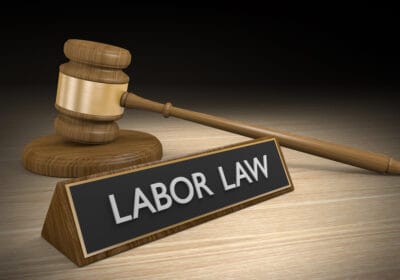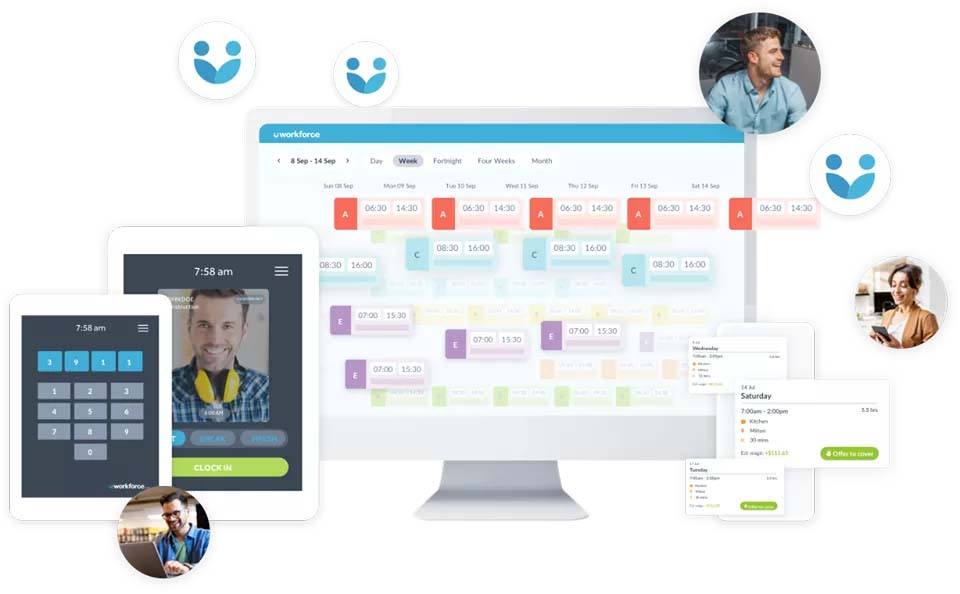Summary:
- Inconsistent shifts and sudden schedule changes place undue financial and logistical stress on the lives of employees outside of work.
- Predictive scheduling laws address this issue by mandating advance notice for schedules and premium pay for sudden shift changes. However, navigating these laws can be challenging due to varying city and state regulations.
- Employers navigate predictive scheduling laws with specialized software that accounts for local labor ordinances, enforces fair scheduling practices, automates predictability pay, and maintains records.
Unpredictable shifts and last-minute changes have long been sources of financial instability and stress among hourly workers. In response, some cities nationwide have implemented predictive scheduling laws, also known as Fair Workweek laws, to create more predictable and transparent schedules for employees.
While predictive scheduling laws are intended to improve worker well-being and foster a healthier workplace, it is not always easy for employers to implement these new standards. Understanding the ins and outs of these ordinances is essential to avoid penalties and maintain workforce satisfaction and productivity.
Whether managing a retail chain, restaurant, hotel, or any business with hourly staff, this article will help you balance operational flexibility with legal compliance.
What are predictive scheduling or Fair Workweek laws?
Predictive scheduling laws are ordinances that promote fair schedule processes, including giving sufficient notice to employees about their work schedules.
While Fair Workweek ordinances may vary city by city, they typically include the following:
- Advance notice of work schedules, typically 14 days in advance
- Predictability pay or premiums when schedules change after the notice period
- Right to rest between shifts or clopening bans
- Right to decline shifts made past the advance notice or opportunities for extra hours
- Good faith estimates of work schedules upon hiring
The impact of unpredictable schedules on workers
Unpredictable schedules are a significant source of disruption in workers’ personal lives. Employees cannot properly budget for the month, make plans with acquaintances, or reliably fulfill other obligations without an appropriate degree of certainty in their work schedule.
For shift-based workers, flexibility means knowing their work schedules well in advance, not the day before a shift so that they can plan for childcare, doctor’s appointments, second jobs, studies, and other obligations.
Financial pain points are another issue workers must contend with when their schedules are unpredictable. It’s hard for them to anticipate their earnings and manage their budgets when their income is erratic.
In response, some cities have passed rules around predictive scheduling to help alleviate such challenges for employees. So, which places implement Fair Workweek ordinances?
Where are predictive scheduling laws being implemented?
Oregon is the only place where predictive scheduling laws are being implemented state-wide so far.
Covered employers
Businesses in the retail, hospitality, and food services industries that have at least 500 employees
Advance notice requirements
- 14 days in advance, including on-call work
- Good faith estimates upon hiring
- Employees can decline shifts that are not included in the written work schedule.
Predictability pay
Employees are entitled 1 hour at regular rate of pay plus wages if the following changes are made without advance notice:
- Additional 30 minutes or more to a shift
- Date or time change of a shift with no loss of hours
- Additional work or on-call shift
Employees are entitled to half of their regular rate of pay if:
- Hours are subtracted from the shift before or after they report for duty
- Changes result in loss of shift hours
- A shift is canceled
- When they are scheduled for on-call work but are not called in
Rest hours and clopening
There must be a rest period of 10 hours in betweeen shifts. Employees can decline the rest period and be paid time and a half pay.
Exceptions
Additional pay is not required for schedule changes due to natural disasters or events outside an employer’s control, such as floods, earthquakes, tsunamis, wildfires, extreme temperatures, war, or explosions.
California
Covered Employers
- Employers in the City of Berkeley with 10 or more employees in the:
- Building services, healthcare, hotel, manufacturing, retail, or warehouse services with 56 or more employees globally
- Restaurant industry and has more than 100 employees globally
- Franchisees primarily engaged in the retail or restaurant industries associated with a network of franchises that employ 100 or more globally
- Non-profit organizations in the building services, healthcare, hotel, manufacturing, retail, warehouse services, or restaurant industries and employ 100 or more globally
Advance notice requirements
- 14 days or two weeks’ notice
- Good faith estimate for new employees
- Employees have the right to decline hours that are added after the notice period.
Predictability pay
- 1 hour of predictability pay for any schedule change made between 1 and 14 days before a shift.
- Up to 4 hours of predictability pay (or the number of hours reduced, whichever is less) for cancellations or reduced hours with less than 24 hours’ notice.
- 1 hour of predictability pay for adding, changing, or moving a shift with less than 24 hours’ notice.
Rest hours and clopening
Employers must allow employees to decline shifts that occur less than 11 hours apart.
Exceptions
Predictability pay is not applicable to employee-initiated shift swaps or changes. It is also not owed for grace periods of 10 minutes before and after a shift.
Access to hours for existing employees
Employers must offer any additional hours to existing part-time employees before hiring new staff or temporary workers.
Covered employers
Employers with nonexempt full-time, part-time, on-call, contract, and seasonal employees that are in:
- Retail with 56 or more employees globally
- Fast food with 56 or more employees globally or 20 or more employees in Emeryville
This includes franchisees associated with a franchisor or a network of franchisees with more than 12 locations globally.
Employers located outside the city but employ workers performing work in Emeryville are also covered.
Advance notice requirements
- 14 days in advance
- Good faith estimate to new employees
- Employees can decline unscheduled hours given less than the notice.
Predictability pay
- If a schedule change is made between 1 and 14 days before the shift, employees receive 1 hour of pay for any affected shift.
- For cancellations or reduced hours with less than 24 hours notice, employees get the lesser of 4 hours of pay or the originally scheduled hours.
- Any other changes made within 24 hours will give employees 1 hour of pay.
Rest hours and Rest hours and clopening
Employers must pay time and half pay for any hours worked for shifts that are less than 11 hours apart.
Exceptions
Predictability pay does not apply to employee-initiated shift swaps or for grace periods of 10 minutes or less before and after a shift. The same goes for an employee who works past the schedule to finish a transaction.
Access to hours for existing employees
Employers must offer additional hours to existing qualified part-time employees until they reach 35 hours of work in a calendar week.
Covered employers
Formula Retail establishments with at least 40 stores worldwide and 30 or more employees in San Francisco, including janitorial and security contractors.
Advance notice requirements
- 2 weeks in advance
- Good faith estimate to new hires
Predictability pay
- 1 to 4 hours of pay for schedule changes made with less than 7 days’ notice
- 2 to 4 hours of pay if an employee is on-call but not called in to work
Exceptions
Predictability pay is not applicable when:
- There is a threat to the safety of employees’ and employers’ property, public utility failure, Acts of God, or causes outside the employer’s control.
- An employee scheduled to work cannot come in and did not provide at least 7 days’ notice.
- An employee failed to report to work or was sent home.
- An employer requires the employee to work overtime.
- An employee swaps shifts with a co-worker or asks for a shift change.
Access to hours for existing employees
Employers must first offer additional work to existing part-time employees as determined by the employer or if the part-timer has done similar work.
Covered employers
Retail businesses with 300+ employees globally
Advance schedule notice period
- 14 days notice
- Good faith estimate for new employees
- Employees reserve the right to decline hours, shifts, and work locations made after the advance notice period.
Predictability pay
- 1 hour at the regular rate for any increase in hours over 15 minutes
- 1 hour at the regular rate for changes in the date, time, or location without changing the hours
- Half the regular rate for a reduction in hours by 15 minutes or more
- Half the regular rate for on-call hours when the employee isn’t called to work
Rest hours and Rest hours and clopening
Employees must not work a shift that starts less than 10 hours from the previous shift. Otherwise, employees must provide written consent, and time and a half pay applies for shifts following an insufficient rest period.
Exceptions
Predictability pay does not apply if:
- An employee initiated the schedule change.
- An employee agrees to cover an absent employee’s shift, provided the employer informs them that it’s voluntary and they can decline.
- The employee’s hours are reduced due to a violation of law or company policy.
- The employee accepts additional hours offered under section 185.05.
- The employer’s operations are affected by legal issues or force majeure.
Access to hours for existing employees
Employers must offer work to current employees at least 72 hours before hiring a new employee or using a contractor, temporary service, or staffing agency to perform work.
Illinois
Covered employers
- Employers that have at least 100 employees globally in the building services, healthcare, hotels, manufacturing, and warehouse services industries
- Restaurant businesses with 250 employees and 30 locations
- Employers with employees earning less or equal to $31.85 per hour or less than or equal to $61,149.35 in a year
Advance notice requirements
- 14 days’ notice
- Written estimate of work hours for new employees
Predictability pay
- 1 hour of pay for every affected shift if the employer subtracts, adds, and changes shifts with no loss of hours after the 14-day notice period
- 1 hour of additional pay for every affected shift when an employer adds hours or changes shifts with no loss of hours less than 24 hours before a shift
- 50% of pay for lost hours when the employer subtracts hours less than 24 hours before a shift starts
Rest hours and clopening
Employees can decline shifts that start less than 10 hours after their last shift. If they work a shift within that time, they must be paid 1.25 times their regular rate.
Exceptions
Predictability is not applicable in cases of:
- Threats to employers, employees, property, or when authorities advise against work.
- Utility failures (electricity, water, gas, or sewer issues) at the workplace.
- Natural disasters like floods, earthquakes, tornadoes, or blizzards.
- War, civil unrest, strikes, safety threats, or pandemics.
- Shift trades or coverage agreed upon by employees.
- Schedule changes mutually agreed upon by employee and employer, confirmed in writing.
- Schedule changes requested by the employee, confirmed in writing.
- Reduction in hours for documented disciplinary reasons.
Access to hours for existing employees
Employers must first offer extra shifts to qualified employees. If no employees accept, the shifts can be offered to temporary or seasonal workers who have been with the employer for at least two weeks.
Covered employers
Employers with:
- 100 or more employees globally, franchises included, in the hospitality, retail, warehouse services, manufacturing, and building services industries
- At least 30 locations globally and 300 employees in the food service and restaurant industry
Advance notice requirements
- 14 days notice
- Good faith estimate for new employees
Predictability pay
- 1 hour of predictability pay if employers add hours or change the date/time of a shift after the 14-day notice period, with no loss of hours.
- 1 hour of predictability pay if employers reduce hours from a regular or on-call shift with more than 24 hours notice.
- If less than 24 hours notice is given, employees may receive up to 4 hours of predictability pay, depending on the number of hours affected.
- For on-call employees not called in, the employer must pay half of the missed hours or 4 hours, whichever is less, if the employee isn’t being paid their regular rate.
Rest hours and clopening
Employees must be paid 1.5 times their regular rate for any hours worked less than 11 hours after their last shift. They must provide written consent to work within this 11-hour window.
Access to hours for existing employees
Employers must offer extra shifts to qualified employees first. If no employees take the shifts, they can be offered to temporary or seasonal workers who have been with the employer for at least two weeks.
New York
New York City
Fair Workweek rules in New York City apply to two work sectors — fast food and retail industries.
Covered employers
- Fast food establishments that are part of a chain and are one of 30 or more establishments nationally.
- Retail employers that operate one or more retail establishments in New York City
Advance notice requirements
- Fast food businesses must give regular schedules that stay the same week-to-week and must give schedules 14 days in advance.
- Retail employers must give 72 hours’ advance notice of work schedules. Shift additions and cancellations are prohibited with less than 71 hours’ notice, and there must be no on-call shifts.
- Workers can accept or decline additional work time.
Predictability pay
- Fast food employers must pay $10 to $75 for every change made to a shift after the notice period for
- Retail employers must pay $300, as well as damages, to the affected workers. A fine of $500 can also be imposed. It could be more if the employer violated the law before.
Rest hours and clopening
Fast food employers are not required to pay premiums for schedule changes due to:
- Threats to employees’ or employers’ property
- Public utility failure or public transport shutdown
- Natural disasters such as fire or flood
- Federal, state, or local state of emergency
- Severe weather conditions that can compromise employee safety
- Employee-initiated changes such as time off requests, using sick leaves, arriving late, or needing to leave early (must be adequately documented)
More about New York City’s Fair Workweek Laws for Fast Food and Retail Businesses
Pennsylvania
Covered employers
Employers with more than 250 employees worldwide and 30 or more locations worldwide, including chains and franchises in the service, retail, and hospitality industries.
Advance notice requirements
- 14 days’ notice
- Good faith estimate upon hiring an employee
- Employees may decline additional work hours not posted in the schedule after the notice period.
Predictability pay
- 1 hour of regular rate of pay when the employer adds time to a scheduled shift. The same applies when changes are made to the date, time, or location with no loss of hours.
- Half of the regular rate of pay for any scheduled hours the employee does not work due to reduced hours from a regular or on-call shift. The same applies when an on-call shift is canceled.
Rest hours and clopening
There should be a rest period of at least 9 hours between shifts. Otherwise, an employee must consent in writing. Employers must also pay $40 for each clopening shift.
Access to hours for existing employees
Before hiring new employees or using subcontractors or staffing agencies, the employer must first offer available shifts to existing employees.
Washington
Covered Employers
- Retail and food service establishments with at least 500 employees worldwide
- Full-service restaurants that have at least 40 full-service locations worldwide
Advance notice requirements
- 14 days advance notice
- Good faith estimate for new employees
- Employees can decline hours not in the originally posted schedules
Predictability pay
- 1 hour of pay for hours added to a shift or when the date or time is changed
- Half of the hours not worked when an employee is sent home early
- Half of the hours not worked when an employee is scheduled for on-call work but is not called in
Rest hours and clopening
There must be 10 hours of rest in between shifts. Employees are entitled to time and a half pay for clopening hours that are less than 10 hours apart.
Exceptions
Predictability pay is not applicable when:
- The employee asked for the changes in schedule or traded shifts with a co-worker.
- The employee responded to a message about available hours because another employee couldn’t work.
- The employee replied to a message about hours available due to unexpected customer needs.
- The reduction in hours was due to discipline.
- The change was due to threats, public official recommendations, utility failures, natural disasters, or legal issues.
Access to hours for existing employees
The employer must offer extra hours to current employees before hiring external candidates, subcontractors, or temporary workers. Employers must post a notice of available hours for three days. Employees have two days to decide if they want the extra hours before the employer hires outside help.
Compliance Tips for Fair Workweek Ordinances
Implementing predictive scheduling laws into your operations can be complicated – it’s easy to overlook crucial details if your policies aren’t thorough. Here are some practical tips to help your business remain on the right side of the law.
Stay abreast of ordinances in your place of business
Only a handful of cities have an ordinance for predictive scheduling, but this could change in the future. It’s best to stay informed about any updates or new regulations in your area.
Keeping up with changes is crucial if you’re in a city or state that has existing Fair Workweek laws. For example, New York City previously required fast food employers to provide a good faith estimate of work hours to new hires, but this was replaced with a mandate for regular week-to-week schedules.
Check with local and state governments regularly for updates on employment laws and scheduling practices to ensure your business remains compliant.
Invest in predictive scheduling software
Predictive scheduling laws are just one of the many employment regulations that businesses must comply with. Many businesses invest in scheduling and payroll solutions that help mitigate predictive scheduling headaches. Software like this automates key areas like shift notifications and predictability pay, ensuring that you meet Fair Workweek standards.
Workforce.com, a scheduling and payroll platform designed for hourly workforces, specializes in predictive scheduling and Fair Workweek compliance. Here’s how it can help:
- Shift scheduling and labor forecasting – Avoid over or understaffing with demand-based schedules. Workforce.com can use data that indicates possible demand, such as historical sales, foot traffic, booked appointments, and even weather information, so you can schedule the correct number of staff for each shift well in advance.
- Alerts and announcements—A critical part of Fair Workweek ordinances is ensuring employees are notified of posted schedules in time. Workforce.com makes this easy—once a schedule is published, employees are notified through the app, and you can also print the schedule. A robust communications feature lets you send announcements about schedule updates and live chat with staff and managers to maximize transparency and efficiency.
- Pay rules – Assign pay rules to each employee, including those predictability pay they may be entitled to when certain conditions get triggered. Once set up, these rules are automatically applied during payroll, eliminating the need for manual entries and calculations.
- Employee tags and classification – Assign tags to covered employees of predictive scheduling rules to ensure they receive the correct pay when predictability pay conditions are met. You’ll also receive automatic alerts when scheduling an employee at risk of working a clopening shift.
- Shift swapping – Workforce.com has shift-swapping functionality that allows qualified staff to take up vacant shifts. This helps automate the process and provides a simple way to track and record shift changes.
- Payroll – Another crucial part of complying with predictive scheduling laws is ensuring covered employees are paid what they’re owed, including applicable predictability pay. Workforce.com automatically computes wages, overtime, deductions, and predictability pay premiums based on timesheets and hours worked by your employees.
- Recordkeeping – Employers are required to maintain records of schedules and documentation related to Fair Workweek compliance. Workforce.com centralizes this information, making it easily accessible. In the event of an audit or when you need to retrieve these records, everything is organized and readily available.
Train managers and HR teams
Managers and human resources are at the frontline of implementing predictive scheduling laws. Train them to understand the specifics of these ordinances and how to communicate them to staff. As a crucial part of compliance, they must have the training and resources to ensure company policies align with and adhere to applicable labor laws.
Why fair scheduling practices matter
Fair scheduling practices are essential to any hourly workforce, regardless of whether predictive scheduling laws exist in your area. Equitable workplace policies should not just stem from the need to comply – they should begin with the desire to equip and support your employees.
A consistent and transparent scheduling system minimizes scheduling conflicts, reduces absenteeism, improves retention, and provides flexibility for hourly staff. This should be standard practice, whether mandated by law or not. Discover how Workforce.com helps you implement best practices with employee scheduling, payroll, and HR for hourly workforces. Book a demo today.

















 Predictive scheduling laws across the United States
Predictive scheduling laws across the United States

 The COVID-19 pandemic has had a few notable impacts on fair workweek laws in 2020, he added. Industries like retail, food service and hospitality that have been greatly impacted by the pandemic are also the industries primarily impacted by predictive scheduling laws. While COVID-19 has not stopped cities and states from enacting the laws currently in place, it’s uncertain if new laws will continue with the same momentum as they did pre-pandemic.
The COVID-19 pandemic has had a few notable impacts on fair workweek laws in 2020, he added. Industries like retail, food service and hospitality that have been greatly impacted by the pandemic are also the industries primarily impacted by predictive scheduling laws. While COVID-19 has not stopped cities and states from enacting the laws currently in place, it’s uncertain if new laws will continue with the same momentum as they did pre-pandemic.